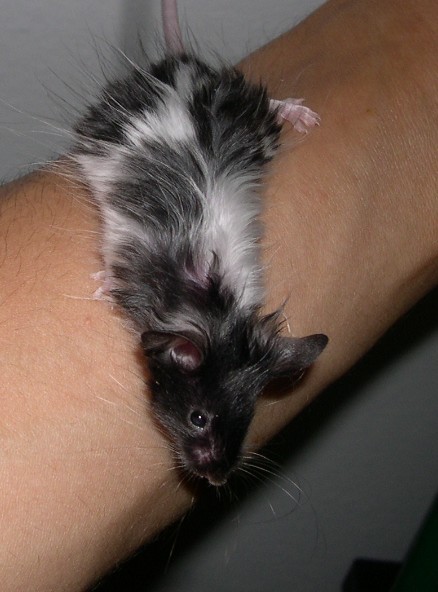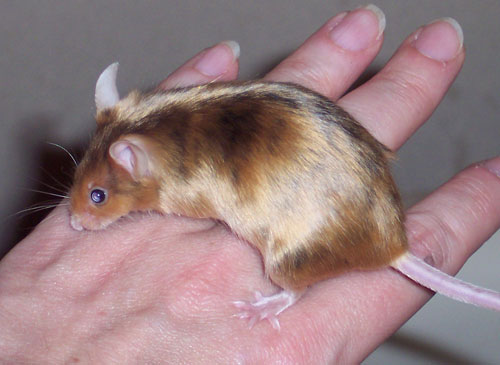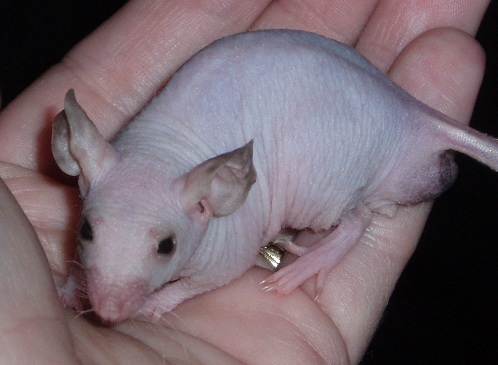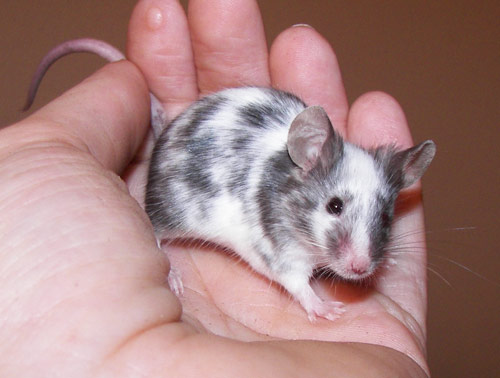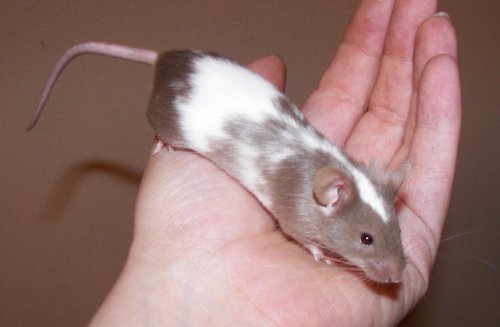|
| Please note that these pages are the result of a LOT of hard work by the people at PetRodents, unpaid work at that, and all text and images are copyrighted. If you really like what you see, please link to us so these hard-working folks get the credit they so richly deserve for this labour of love. Thanks! |
|
|
|
|
|
|
|
|
|
|
|
T
|
The dominant state of this allele is tailless, with heterozygotes (T/t) displaying varying degrees of taillessness, from short tails, stubs, or a total absence of a tail. There is also modification to the pelvic girdle in tailless mice, and this aids in distinguishing true tailless mice from those who have lost their tails through mechanical means.This gene is homozygous (T/T) lethal. |
|
|
|
t
|
This allele produces mice with normal tails.The modifier tn is homozygous lethal.
|
|
|
|
|
|
|
|
|
Coat Types
|
| Note: Unless otherwise noted, all alleles in this section are recessive and the mouse must be homozygous (i.e. two of each) for the trait to be expressed. It has been assumed that the heterozygous form of each locus is phenotypically (i.e. looks like) a normal type. |
|
|
|
|
|
go
|
Hair is longer than normal mice, appearing by 3 weeks of age
(21 days). Both guard hairs and undercoat are long, and can produce the appearance of “fluffiness” in some mice. |
|
|
|

|
|
|
|
|
|
|
|
|
|
sa
|
The coat is soft and extremely shiny; the sheen making it appear
as if made of satin. Has been linked with a genetic disorder which causes babies to wither and die between the 7-10 day stage of growth. |
|
|
|

|
|
|
|
|
|
|
|
|
|
fr
|
| This allele creates a kinky coat, with every hair appearing crimped. Often the hair will lose this crimping by adulthood, which leaves them mouse appearing almost identical to a standard coat. |
|
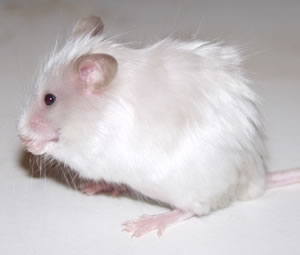
Adult frizzie
|
|

|
|
|
|
|
|
|
|
|
|
fz
|
The hair is thin and wavy or curly, as are the whiskers. Not to
be confused with a true hairless since the hair, while thin, is
present. Mice will retain the curly hair throughout their lives. |
|
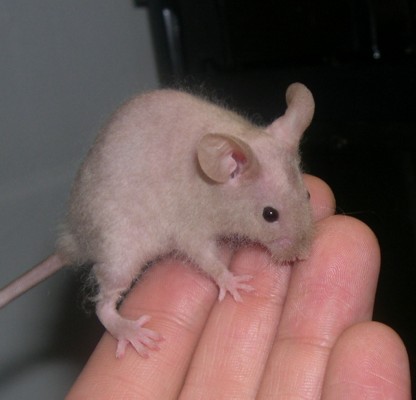
Longhair fuzzy
|
|

|
|
|
|
|
|
|
|
|
|
Re
|
This allele is dominant. The hair is thick and wavy with wavy or curly whiskers. They appear almost like little sheep when young, but will lose much of the curl as they age, although they do retain
a wavy coat as adults.Long haired rex mice (Re/* go/go) are referred to as Texel. |
|
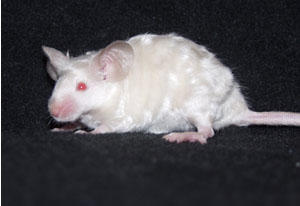
Rex
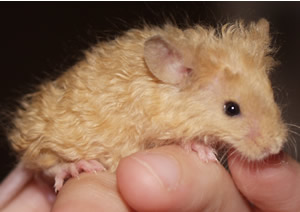
Texel
|
|

|
|
|
|
|
|
|
Ca
|
This allele is dominant. It produces a curly coat, but as the mouse ages the coat loses its curl and adult mice simply appear
“plushy”. |
|
|
|

|
|
|
|
|
|
|
|
|
|
hr
|
Hairless mice initially develop a normal coat at the same time
as their regular siblings, but will lose it at the follicle level after about 10 days of age. Whiskers may or may not be shed. Some
hair will appear and be shed for the first few months of life, but
eventually the mouse will be continually hairless. The skin may
or may not be wrinkled.These mice are susceptible to cold temperatures and may suffer from suppressed immune systems, leading to an increased susceptibility to disease. Toenails often display unrestricted growth and may need to be trimmed. |
|
|
|
|
hrrh
|
This variant of the hairless gene produces mice with thickened skin
that becomes incredibly wrinkled. These mice are often referred to
as “rhino mice” and the periodic return of hair in the early months is not present in these mice. |
|
|
|
|
|
|
|
|
|
Coat Markings
|
|
|
|
|
|
Rn
|
This allele is dominant and produces a scattering of white or very
lightly pigmented hairs throughout the coat.Homozygotes (Rn/Rn) are more definitely marked than heterozygotes (Rn/rn) , but both are equally viable and fertile.Roans with patches of plain black fur are called merle. |
|
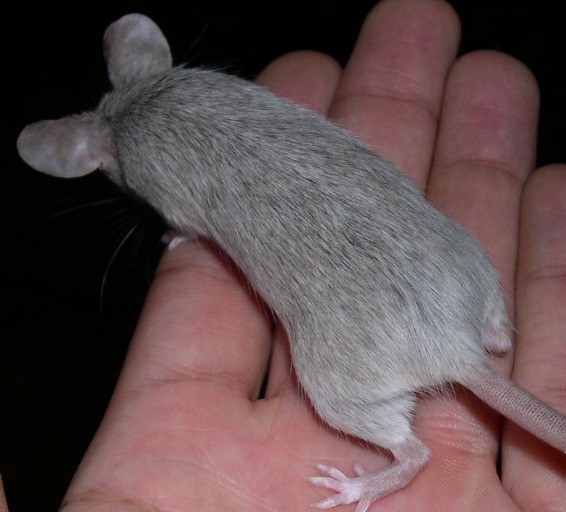
Roan
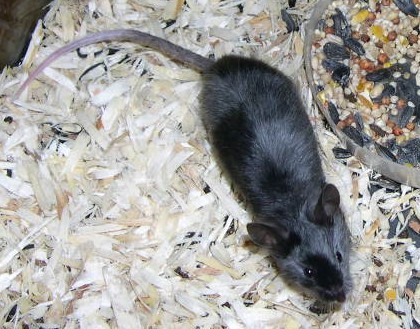
Merle
|
|
|
|
|
|
|
|
|
|
|
|
|
s
|
Produces varying degrees of irregular white spotting over the entire
body in homozygotes (s/s). Has been linked to megacolon in some
cases.Often a dark mouse which carries this recessive will have a small pink patch on or near the end of the tail. |
|
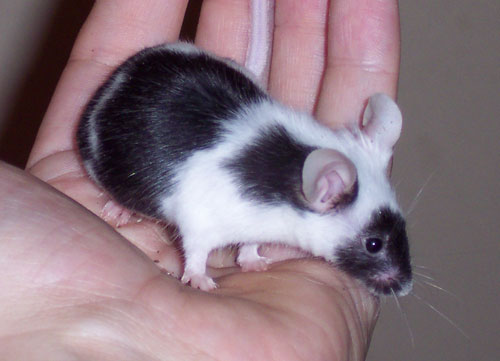
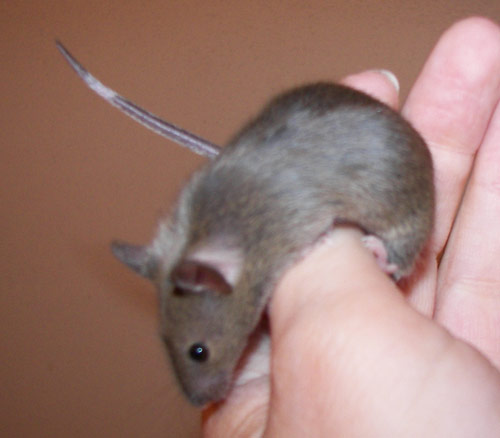
Carrier with white tail spot
|
|
|
|
|
|
|
|
|
|
W
|
This is a dominant allele. A mouse with this gene will appear
variegated or marbled.This is homozygous (W/W) lethal, and mice with this genotype will appear as black-eyed whites (BEW) and will die shortly after birth. |
|
|
|

|
|
|
|
|
|
|
|
Mobr
|
Heterozygous mice will appear patchy or mottled orange and black,
similar to the appearance of tortoishell cats. Usually black is the predominant colour. This allele is dominant.This gene is lethal in males and homozygous females both of whom usually die within 2 weeks after birth. |
|
|
|
|
|
|
|
|
 [/kml_flashembed]
[/kml_flashembed]
